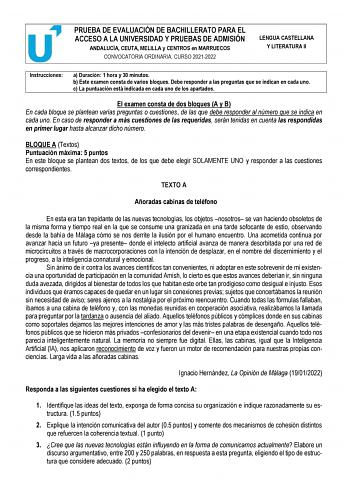Examen de Inglés de Andalucía (PEvAU de 2022)

| Comunidad Autónoma | Andalucía |
|---|---|
| Asignatura | Inglés |
| Convocatoria | Ordinaria de 2022 |
| Fase | Admisión |
Temas mencionados new_releases
Generación del 27
Con el término Generación del 27 se denomina comúnmente a una constelación de escritores españoles, en su mayor parte poetas, del siglo XX que se dio a conocer en el panorama cultural alrededor del año 1927, con motivo del homenaje a Luis de Góngora organizado en ese año por José María Romero Martínez en el Ateneo de Sevilla con motivo del tercer centenario de su muerte, en el que participaron muchos de sus miembros más conocidos, dentro de la llamada "Edad de Plata" de la literatura española, época en que coincidieron en plena producción durante la Segunda República esta brillante promoción j…
Fuente: wikipedia.org
Emily Davison
Emily Davison wearing her hunger strike medal, 1910–1912. Emily Wilding Davison (11 October 1872 – 8 June 1913) was an English suffragette who fought for votes for women in Britain in the early twentieth century. A member of the Women's Social and Political Union (WSPU) and a militant fighter for her cause, she was arrested on nine occasions, went on hunger strike seven times and was force-fed on forty-nine occasions. She died after being hit by King George V's horse Anmer at the 1913 Derby when she walked onto the track during the race.
Fuente: wikipedia.org.jpg?width=300)
Jerry Seinfeld
Jerome Allen Seinfeld (born April 29, 1954) is an American stand-up comedian, actor, writer, and producer. He is best known for playing a semi-fictionalized version of himself in the sitcom Seinfeld, which he created and wrote with Larry David. The show aired on NBC from 1989 until 1998, becoming one of the most acclaimed and popular American sitcoms of all time. As a stand-up comedian, Seinfeld specializes in observational comedy. In 2004, Comedy Central named him as the 12th-greatest stand-up comedian of all time.
Fuente: wikipedia.org
Quinoa
Chenopodium quinoa near Cachilaya, Lake Titicaca, Bolivia. Quinoa (Chenopodium quinoa; from Quechua ' or ') is a flowering plant in the amaranth family. It is a herbaceous annual plant grown as a crop primarily for its edible seeds; the seeds are rich in protein, dietary fiber, B vitamins, and dietary minerals in amounts greater than in many grains. Quinoa is not a grass, but rather a pseudocereal botanically related to spinach and amaranth (Amaranthus spp), and originated in the Andean region of northwestern South America. It was first used to feed livestock 5,200–7,000 years ago, and for human consumption 3,000–4,000 years ago in the Lake Titicaca basin of Peru and Bolivia.
Fuente: wikipedia.orgWorld War I
World War I (WWI or WW1), also known as the First World War, the Great War, or the War to End All Wars, was a global war originating in Europe that lasted from 28 July 1914 to 11 November 1918. More than 70 million military personnel, including 60 million Europeans, were mobilised in one of the largest wars in history. Over nine million combatants and seven million civilians died as a result of the war (including the victims of a number of genocides), a casualty rate exacerbated by the belligerents' technological and industrial sophistication, and the tactical stalemate caused by gruelling tre…
Fuente: wikipedia.org
Ancient grains
Wild cereals and other wild grasses in northern Israel. Ancient grains is a marketing term used to describe a category of grains and pseudocereals that are purported to have been minimally changed by selective breeding over recent millennia, as opposed to more widespread cereals such as corn, rice and modern varieties of wheat, which are the product of thousands of years of selective breeding. Ancient grains are often marketed as being more nutritious than modern grains, though their health benefits have been disputed by some nutritionists.
Fuente: wikipedia.org

